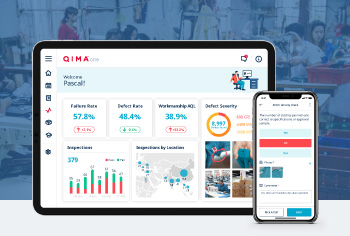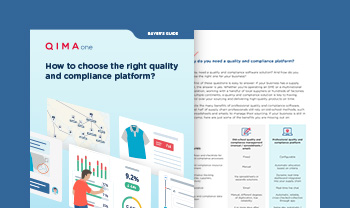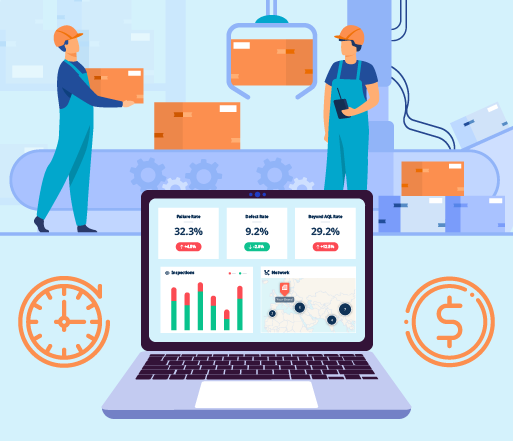
Articles
How To Establish Continuous Quality Management Improvement Practices

Articles
How To Establish Continuous Quality Management Improvement Practices
Articles
How To Establish Continuous Quality Management Improvement Practices

随时了解最新的供应链信息。
In order to plan and implement quality management improvement practices, you must first achieve supply chain visibility, capture actionable production data, and establish clear lines of communication.
This article will first look at how your business can benefit from good quality management improvement practices, and present some basic principles that underlie quality management improvement. Finally, we'll provide you with some useful tools for building an effective quality management framework.
How Good Quality Management Improvement Practices Lead to Success
Without a coherent quality management improvement program and the ability to stay on top of every last performance detail, quality problems will inevitably grow into profit-eroding catastrophes. This is why companies that rely largely on reactive, ad hoc measures to patch up production problems tend to remain at constant risk and barely keep their heads above water. Establishing a strong quality management process from the start is practically indispensable for companies reliant on supply chains covering multiple continents, cultures, languages and disparate regulations.
Knowing this, industry leaders make sure to invest time and resources into a preventive approach to quality management, with continuous analysis and review that help them minimize substandard quality and inefficient production methods. Foresight like this allows them to focus primarily on improvement and innovation.
The Fundamental Principles Behind the Quality Management Improvement Process
1. Establish a Culture of Quality
By establishing a culture of quality through daily practices, procedures and expectations, you can impress upon your business partners a commitment to quality, consistency and efficiency.
Delivering a detailed program and usable tools is further evidence that you have made the initial investment to ensure your QMI process hits the ground running.
2. Achieve Supply Chain Visibility
We cannot improve what we cannot see. Supply chain visibility allows companies to see how every aspect of production works, and works together, to create a line of goods fit for national and international markets. There are too many factors which, if not monitored continuously, can pose a risk to the entire enterprise.
3. Pinpoint Improvement Areas
The devil and the development are in the details! After achieving visibility over every aspect of your production and delivery process, your company and its network of responsible managers can isolate each process function, such as factory line assembly, packaging and labeling.
Additionally, the same efficiency evaluations can be used to see how each individual process fits alongside its neighboring processes. For example: your automobile parts may be consistently meeting your quality control (QC) specifications, while also being manufactured or warehoused in a way that creates assembly or delivery delays.
4. Collect and Analyze Data
Quantifiable data and analysis--like identifying alarming failure rates--will help everyone determine and prioritize improvement areas, with KPIs that can be measured against future success rates.
5. Communicate Inspection Data Results
Capturing pertinent data is not enough to drive improvement--it must also be effectively communicated to all supply chain managers and in-house inspectors. To help all parties make the most of valuable QC data, establish clear lines of communication that are easy to access and use.
6. Maintain Continuous Evaluation
A proper production process is continuous, without a single static moment or a break in the action. Your evaluation efforts should be equally dynamic and continuous: you cannot drive improvement with a one-and-done inspection plan or infrequent communication.
Building a Quality Management Improvement Framework
The ongoing digital revolution is increasingly bringing global supply chains together in unified platforms, with specialized quality management software designed to help companies take control of their supply chain and drive continuous improvement. Today, leading companies use the following three methods to ensure quality and efficiency, enhanced by technology.
1. Supply Chain Process Mapping
Process mapping is a proven tool for achieving visibility across your supply chain. Just like an easy-to-read road map, this tool organizes every supply chain partner by location, responsibility, quality and compliance requirements, and role in the overall production cycle.
Physical activities can be tracked at every tier of production alongside testing, inspection and certification (TIC) data, so that all successes (and failures) are accounted for.
2. Risk Area Analysis
The root of some production problems and inefficiencies often isn’t readily apparent. To identify the underlying cause of quality issues, companies may need to investigate multiple possibilities. Data analysis helps identify root causes and potential risk areas in the production process, be they manpower, machinery, or improper training.
When you have the data on the root causes of quality issues and risk areas in your supply chain, as well as a systematic way to quantify and record successes and failures, you can create an improvement plan that is properly prioritized, specific, and flexible enough to adapt to change.
3. Plan-Do-Check-Act (PDCA)
The PDCA methodology is ideal for initiating and achieving continuous quality management improvement across your supply chain. This is because PDCA: 1) emphasizes action at every step; and 2) places great importance on early-stage, Quality Assurance planning.
By iterating on each step of the Plan-Do-Check-Act cycle, you can combine planning with actionable practices, encouraging organized, proactive habits in your entire supply chain, which will help you and your production partners eliminate production quality failures and inefficiencies.
Importantly, this reiterating cycle always returns to planning improvements based on the performance results, allowing you to isolate potential improvement areas and develop further improvement measures--which, in turn, will be tested again.
How Can QIMAone Help?
QIMAone's quality and compliance software is designed to bring together your supply chain partners and their various TIC requirements into one harmonious communication and data-sharing platform.
Backed by over 15 years of TIC-service experience, our supply chain management format will allow your company to achieve full visibility over your product and processes--from sourcing to shelves and tables.
We provide mapping capabilities that help you keep track of all sites involved in the harvesting, manufacturing, storage, shipment and sales of your products, enabling you to:
- Identify potential risk areas;
- Implement actionable improvement plans; and
- Maintain accountability for your uncompromising standards.
Additionally, real-time inspection monitoring encourages responsible managers to address problems as they are detected, and not hours, days or weeks later, by which time the problem will have grown too large to be handled efficiently.
Finally, QIMAone provides a library of standardized inspection templates, along with customizable workflows that will help train your in-house inspectors in performing the routine quality checks, so that your third-party inspection budget can be reserved for more complicated tests or cases when independent review is required.
QIMAone is ready to help your business hit the ground running with continuous quality management improvements.
Learn more about QIMAone applications by scheduling a demo today.













